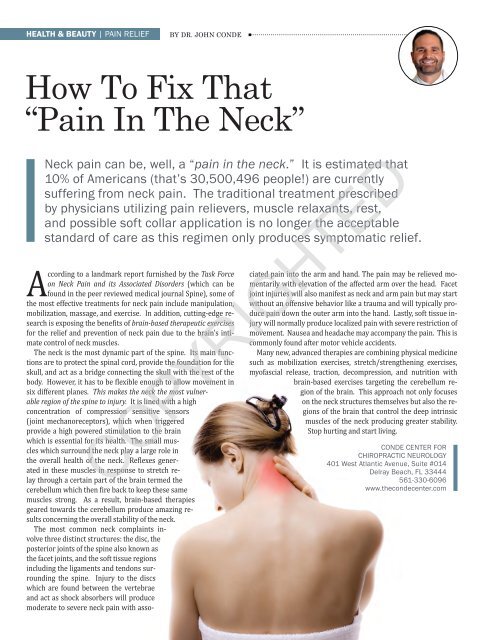Atlantic Ave Magazine September 2019
Create successful ePaper yourself
Turn your PDF publications into a flip-book with our unique Google optimized e-Paper software.
health & beauty | pain relief<br />
By dr. john conde<br />
How To Fix That<br />
“Pain In The Neck”<br />
Neck pain can be, well, a “pain in the neck.” It is estimated that<br />
10% of Americans (that’s 30,500,496 people!) are currently<br />
suffering from neck pain. The traditional treatment prescribed<br />
by physicians utilizing pain relievers, muscle relaxants, rest,<br />
and possible soft collar application is no longer the acceptable<br />
standard of care as this regimen only produces symptomatic relief.<br />
According to a landmark report furnished by the Task Force<br />
on Neck Pain and its Associated Disorders (which can be<br />
found in the peer reviewed medical journal Spine), some of<br />
the most effective treatments for neck pain include manipulation,<br />
mobilization, massage, and exercise. In addition, cutting-edge research<br />
is exposing the benefits of brain-based therapeutic exercises<br />
for the relief and prevention of neck pain due to the brain’s intimate<br />
control of neck muscles.<br />
The neck is the most dynamic part of the spine. Its main functions<br />
are to protect the spinal cord, provide the foundation for the<br />
skull, and act as a bridge connecting the skull with the rest of the<br />
body. However, it has to be flexible enough to allow movement in<br />
six different planes. This makes the neck the most vulnerable<br />
region of the spine to injury. It is lined with a high<br />
concentration of compression sensitive sensors<br />
(joint mechanoreceptors), which when triggered<br />
provide a high powered stimulation to the brain<br />
which is essential for its health. The small muscles<br />
which surround the neck play a large role in<br />
the overall health of the neck. Reflexes generated<br />
in these muscles in response to stretch relay<br />
through a certain part of the brain termed the<br />
cerebellum which then fire back to keep these same<br />
muscles strong. As a result, brain-based therapies<br />
geared towards the cerebellum produce amazing results<br />
concerning the overall stability of the neck.<br />
The most common neck complaints involve<br />
three distinct structures: the disc, the<br />
posterior joints of the spine also known as<br />
the facet joints, and the soft tissue regions<br />
including the ligaments and tendons surrounding<br />
the spine. Injury to the discs<br />
which are found between the vertebrae<br />
and act as shock absorbers will produce<br />
moderate to severe neck pain with associated<br />
pain into the arm and hand. The pain may be relieved momentarily<br />
with elevation of the affected arm over the head. Facet<br />
joint injuries will also manifest as neck and arm pain but may start<br />
without an offensive behavior like a trauma and will typically produce<br />
pain down the outer arm into the hand. Lastly, soft tissue injury<br />
will normally produce localized pain with severe restriction of<br />
movement. Nausea and headache may accompany the pain. This is<br />
commonly found after motor vehicle accidents.<br />
Many new, advanced therapies are combining physical medicine<br />
such as mobilization exercises, stretch/strengthening exercises,<br />
myofascial release, traction, decompression, and nutrition with<br />
brain-based exercises targeting the cerebellum region<br />
of the brain. This approach not only focuses<br />
on the neck structures themselves but also the regions<br />
of the brain that control the deep intrinsic<br />
muscles of the neck producing greater stability.<br />
Stop hurting and start living.<br />
Conde Center For<br />
ChiroprACtic Neurology<br />
401 West <strong>Atlantic</strong> <strong>Ave</strong>nue, Suite #014<br />
Delray Beach, FL 33444<br />
561-330-6096<br />
www.thecondecenter.com<br />
COPYRIGHTED

















